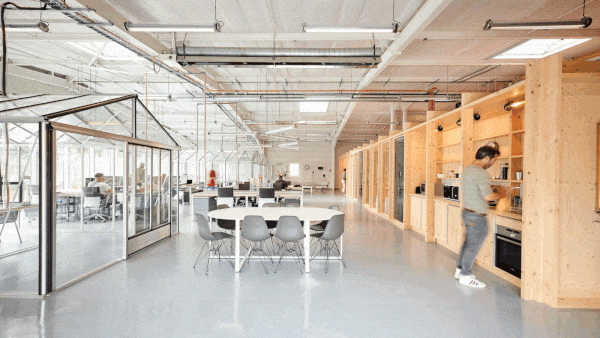Room psychology and light: planning and lighting New Work workplaces correctly
In our modern, technology-driven world, we spend a considerable amount of time at our desks. Whether in the office, working from home or at other workplaces – the design of our working environment plays a decisive role in our well-being and performance.
In this article, we will take a closer look at the role of spatial psychology and light in the design of workplaces in the context of New Work.
We will explore how conscious planning and the right lighting can help to create working environments that are not only functional, but also inspiring and conducive to employee wellbeing.
The importance of spatial psychology for workplaces
Spatial psychology is an interdisciplinary field that deals with the interaction between people and their physical environment. She investigates how the design of spaces influences our mood, our behaviour and our performance, which is of course particularly important in New Work space concepts. Room psychology takes a variety of factors into account, including room layout, colour scheme, furniture arrangement, lighting and acoustics.
Why is spatial psychology important?

A workplace designed according to the principles of spatial psychology can influence the following factors:
- Mood and well-being: An attractively designed working environment can also have a positive impact on employees’ mental health. It can reduce stress, increase motivation and create a positive working environment.
- Behavior and interaction: The way a space is designed can influence the behavior and interaction of the people in it. An open, inviting design can encourage communication and collaboration, while a cluttered or unpleasant environment can restrict interaction.
- Performance and productivity: A well-organized workplace with ergonomic furniture and adequate lighting can increase efficiency and improve work performance.
The influence of interior design on mood, behavior and performance in the workplace in the context of New Work
The interior design of an office workplace can influence various aspects of the human experience.
- The choice of colours and colour psychology in general play an important role. Warm colours such as yellow and orange can create an inviting and energising atmosphere, while cool colours such as blue and green can have a calming and relaxing effect.
- The room layout can influence employees’ freedom of movement, privacy and interaction. An open-plan layout can encourage communication, while individual work areas can support concentration and productivity.
- Last but not least, lighting is a decisive factor for the mood and performance at the workplace. Natural daylight is ideal, but artificial lighting should also be carefully planned to avoid glare and fatigue and to create a pleasant working atmosphere.
By taking these and other principles of spatial psychology into account, working environments can be created that are not only functional, but also support the well-being and performance of employees, which is in line with the principles of the New Work movement.
The role of lighting in workplace design
The importance of light for well-being and productivity
Light not only improves visibility, but also has a significant influence on the well-being and performance of employees in New Work space concepts. The physiological effects of light on people are diverse and range from regulating the sleep-wake rhythm to balancing mood swings.

The physiological effects of light on humans
Our body reacts to light by producing hormones such as melatonin and serotonin, which influence our sleep-wake cycle and mood. Natural daylight, especially the bluish light in the morning, signals to our body that it is time to wake up and be active. On the other hand, the warm, reddish light in the evening signals that it is time to rest and helps us to relax.
The importance of daylight and artificial light for health and performance
Daylight strengthens the immune system, improves mood and reduces stress. Maximising the amount of daylight is therefore of crucial importance when planning workplaces. If natural light is not sufficiently available, artificial light can be used as a supplement to ensure adequate lighting.
However, artificial light should be carefully designed to avoid glare and other undesirable effects. A balanced combination of direct and indirect light is perceived as pleasant by employees, as excessive contrasts and striking light and dark zones are avoided.
Lighting design at the workplace
Here are a few tips for optimising workplace lighting:
- Light sources should be positioned so that they evenly illuminate the work area without causing glare or shadows. The general ceiling lighting can be supplemented by individual table or floor lamps.
- LED lamps are not only an energy-efficient option, they also offer a natural quality of light that can be adapted to the variation in light colour of daylight throughout the day with the ‘tunable white’ option.
- Workstations with individually adjustable lamps meet the individual needs of employees and can thus avoid conflicts and promote well-being.
Various lighting systems such as direct, indirect and mixed light
Direct light, which is aimed directly at the work area, provides a clear view and aids concentration. Indirect light, which is reflected from the ceiling or walls, creates softer, more diffuse lighting and reduces glare. A combination of the two, known as mixed light, can ensure optimum lighting in the workplace that is both functional and pleasant.
The importance of spatial psychology and light in workplace design
Emphasising a holistic approach to workplace design, taking into account spatial psychology and lighting, is crucial to creating working environments that are both functional and conducive to employee wellbeing. A holistic approach takes into account not only the physical aspects of interior design, but also the psychological and emotional needs of employees.
The outlook for future developments and trends in workplace design shows an increased integration of spatial psychology and light as key factors in the design of New Work environments. With advancing technology and a growing understanding of the importance of wellbeing in the workplace, innovative approaches and solutions are being developed to further improve employee productivity, satisfaction and health.
By continuing to focus on holistic workplace design and utilising new technologies and insights, we can bring about positive change in the world of work and create working environments that fully support the needs and potential of employees.

Other interesting articles on the subject of lighting and New Work:
- The right lighting at the workplace: light changes spaces, space changes work
- Work Café : Which lighting suits New Work concepts?
- REPLAY – Webinar Light + Space: Planning and illuminating informal meeting rooms


